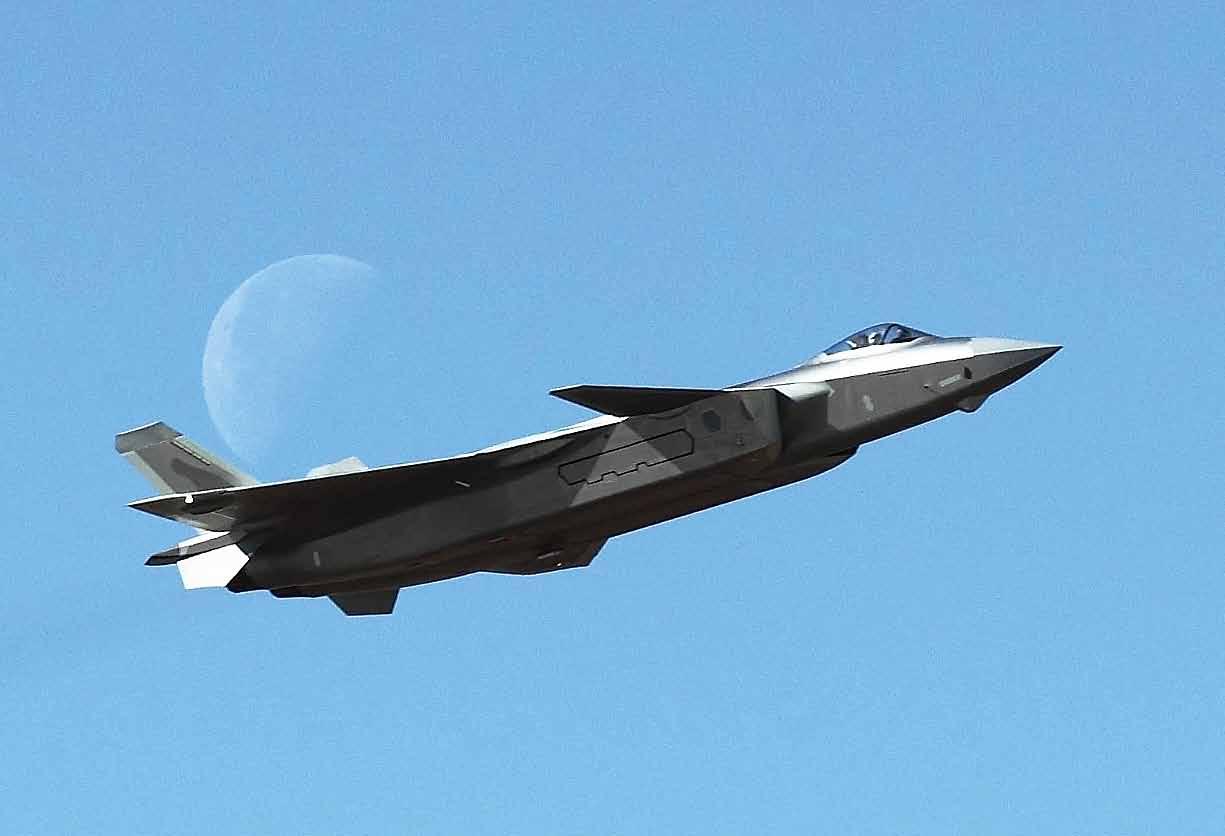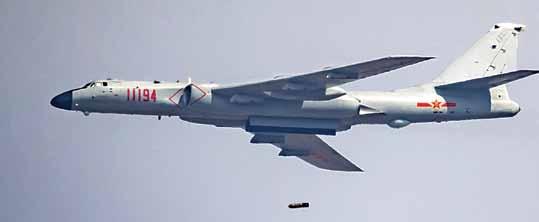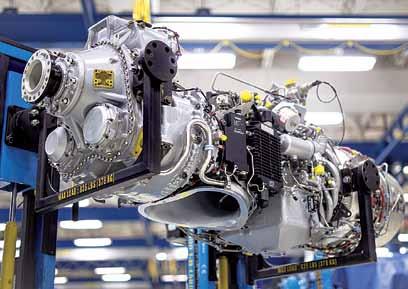
15 minute read
PLAAF
The J-20 and FC-31/J-31 are The Two FiFTh-generaTion FighTer airCraFT programmes oFThe pLaaF
PLAAF’S GROWING THREAT – CHALLENGE FOR THE IAF
Advertisement
With the support of the indigenous industry that is producing a wide range of military aerial platforms, the PLAAF is fast acquiring top-end systems and weapons of global class
By Air MArshAl Anil ChoprA (retd)
The People’s Liberation Army Air Force (PLAAF) of China
has come a long way since its first major air campaign during the Korean War fought in 1953. China began setting up factories to manufacture aircraft initially with the help of the Soviet Union and later managed to get some important technologies from the United States of America (USA). Once its economy began booming in the 1980s, China could make heavier investments in research and development. China’s global ambitions in the last two decades give a much bigger flip to air and sea power. “The air force is a strategic military service that has a vital position and plays a vital role in the overall situation of national security and military strategy,” said Xi Jinping in April 2014.
HIGH TECHNOLOGY AND EMPHASIS ON REALISM
With the support of the indigenous industry that is producing a wide range of aerial platforms for military use, the PLAAF is fast acquiring top-end systems and weapons of global class and reach. There is much greater emphasis on modern technologies including stealth, hypersonic flight, Artificial Intelligence (AI), cyber, electronic warfare and long range missiles. The PLAAF also reoriented its flying training and tactics and there is much higher emphasis on realistic exercises.
DOCTRINAL CHANGES
The PLAAF has made major changes in its operational doctrine based on the need for achieving global reach. Air defence of critical assets, long-range offensive precision strikes, integrated battlefield support missions, intelligence surveillance and reconnaissance (ISR), information operations and strategic airtransport reach are on priority. Integration of air and space will support both offensive and defensive operations. The PLAAF is preparing for hybrid network-centric war and is also trying to increase exposure to air exercises to compensate for the low level of exposure to actual war.
ASSETS OF THE PLAAF
With around 1,700 combat aircraft on its inventory, the PLAAF is the largest air force in the South East Asian region and the third largest in the world. As per Military Balance 2020, the PLAAF operates nearly 850 J-7 variants, 100 J-8s, 465 J-10s, 225 J-11 air superiority fighter variants, 52 Russian Su-27s, 73 Russian Su-30 MKK multi-role aircraft, 24 Russian Su-35S and 176 H-6 jet bomber variants. The PLAAF also has 20 IL-76 jet transport aircraft and around 90 Y-7, Y-8, Y-9 turboprop powered transport aircraft. It has on its inventory three IL-78 MD/TD jet powered aerial tankers of Russian origin and eight Tu-154M Jet patrol/ELINT aircraft. The AEW&C aircraft include four propeller driven KJ-200, five KJ-500 and four KJ-2000
a KJ-500 airborne earLy warning (aew) airCraFT under The pLasouThern TheaTer Command Taxis on a paTroL mission jets. The PLAAF has nearly 350 JL-8 jet trainers and its helicopter fleet consists of 50 Z-8, Z-9 and Mi-17s. Meanwhile, newer Z-18 and Z-20 are under induction. As compared to the PLAF, the PLA has a much larger rotary wing force.
STRUCTURAL CHANGES
The PLAAF is closing the gap with Air Forces of Western nations across a broad spectrum of capabilities such as aircraft performance, command and control as well as electronic warfare. In 2017, China restructured its force as part of a broader plan to introduce reforms in the PLA. Brigades were created under the newly established bases by disbanding fighter and fighterbomber divisions. There are now approximately 59 fighter/ ground attack brigades attached to Bases with the operational commands. In addition, another 35 brigades not subordinate to Bases were also formed. Each Brigade reportedly has 24 aircraft and each bomber regiment has 18 aircraft. The 15th Airborne Corps has been re-designated as the PLA Airborne Corps.
NEWER PLATFORMS
The J-20 and FC-31/J-31 are the two fifth-generation fighter aircraft programmes of the PLAAF. China claims to have inducted 50 J-20s that carry integral weapons and are designed with network-centric warfare technology. The extended range H-6K variant is powered by more efficient turbofan engines and can carry six ALCMs, providing long-range, standoff precision-strike capability. The PLAAF is developing new medium and long range stealth bomber H-20 to strike regional and global targets. It will probably reach initial operational capability no sooner than 2025. China has inducted 20 Y-20 large transport aircraft that can lift
With around 1,700 up to 66 tonnes. The new variants are combat aircraft on planned to support airborne command and control, logistics, para-drop, aerits inventory, the ial refuelling and strategic reconnais-
PLAAF is the largest sance operations.
air force in the South UNMANNED AERIAL PLATFORMS
East Asian region China’s has a growing high-end force and the third largest consisting of indigenous military drones. These include stealthy flyingin the world wing, VTOL platforms, micro-UAVs, unmanned airships, sailplanes and

even ornithopters (flapping wings). The PLAAF’s current platforms in-service are large UAVs that include the BZK-005 (Giant Eagle), the GJ-1 and GJ-2, domestic variants of Wing Loong I and II. These are claimed to be equivalents of MQ-1 and MQ-9, respectively. WZ-7, Divine Eagle is a high altitude jet-powered UAV that is capable of AEW role. The GJ-11 (Sharp Sword) that is a stealthy UCAV and the WZ-8 are supersonic reconnaissance UAVs. The GJ-11 can be used for autonomous missions, autonomous swarming, manned-unmanned-teaming (MUMT), loyal wingman and other concepts. The “Anjian” (Dark Sword) UCAV is a delta wing, twin-tail canard platform similar to the American Global Hawk class HALE UAV. The WZ-2000 is a twin-fin jet powered UCAV that can carry 80 kg payload. CH-3 is a fixedwing UCAV with canard configuration that can carry Anti-Radiation Missile (ARM) as also an Air-to-Surface Missile (ASM) with a Semi-Active Laser (SAL) seeker. The Pakistani Burraq UAV is based on CH-3 UAV and has been supported by China. Media reports have indicated that several countries including Pakistan have faced technical problems with the Chinese CH-4 UAV which is almost identical to the US General Atomics MQ-9 Reaper.
PLAAF WEAPONS
The PLAAF is developing a large number of smart precision ammunitions with surgical strike capability. These include, IR/ TV guided Air to Surface Missiles (ASM) and Anti-Radiation Missiles. The PLAAF has many laser-guided and satellite-guided bombs. The Beyond Visual Range (BVR) Air-to-Air missiles (AAM) include the latest PL-12 and PL-21. The PL-15, very long range AAM, is equipped with an active electronically scanned array (AESA) radar. China has around 500 DH-10 land attack cruise missiles with a 1500 km range and part of these is air launched. The PLAAF has several advanced long range SAM systems and include Russian S-300, the S-400 and domestically produced HQ-9.
PLAAF IN THE WESTERN THEATRE
The PLAAF’s air assets opposite the Indian border across the Himalayas, include one fighter brigade each of J-11AB, J-7, J-7E and J-16 aircraft.
There is a transport regiment each of Y-8/Y-9 and Y-7 aircraft. There is a regiment of helicopters and one SAM brigade at Lhasa. Deeper at Urumqi Base, there is a fighter brigade each of J-8H, J-11A/B and JH-7A. Fighters of the PLAAF carry out regular exercises in the sector. The airfields are being upgraded to host more assets. China is developing new airbase in Shakche in Xinjiang, next to the China Pakistan Economic Corridor (CPEC) and very close to Aksai Chin in Ladakh.
TACTICAL EMPHASIS OF THE PLAAF
Chinese h-6K bomber airCraFTThaT are CapabLe oFCarrying nuCLear weapons The PLAAF believes in long range, offensive precision-strikes using enablers such as flight refuelling aircraft (FRA) and Airborne Warning and Control System (AWACS) Aircraft. There will be coordination with People’s Liberation Army Rocket Force (PLARF). The PLAAF has multi-layered air defence systems. China’s extensive constellation of surveillance satellites with short revisit cycles, greatly support surveillance and targeting. The PLAAF gives greater importance to information, electronic and cyber warfare. The PLAAF also coordinates closely with the PLA Strategic Support Force (PLASSF).
JOINT TRAINING AND INTERNATIONAL EXERCISES
The PLAAF has begun regular exercises that include large force engagements with the PLA and the PLA Navy and their exercises in Tibet have increased. The PLAAF has annual Shaheen series exercises with the Pakistan Air Force (PAF) since 2011. Shaheen IX was held in Pakistan in December 2020. These exercises improve interoperability as also the PAF gets exposure to the Su-30 variants. China get inputs on F-16 and Rafale jets from PAF pilots who exercise with West Asian Air Forces regularly.
CHALLENGES FOR THE IAF
The PLAAF is clearly growing both in technology and numbers. Although it still has limitations in respect of the number of airfields and infrastructure in Tibet, it is quickly building new airfields and infrastructure. The Indian Air Force (IAF) has advantage of much larger number of airfields at much closer distances from the border and lower altitude. The IAF can launch a greater number of missions across the Himalayas. However, the IAF’s fighter squadron strength is very low and needs to be increased to 42 combat squadrons through acquisitions or accelerating indigenisation. The IAF also needs larger number of AWACS and FRA aircraft as also more UCAVs. India also needs to increase cyber and electronic warfare capability. Surfaceto-surface missiles and cruise missile inventories have to go up too. The IAF needs a few more airfields with further improved infrastructure in the Eastern Sector. The IAF will then be a major deterrent to China’s offensive designs against India. SP


Pratt & Whitney’s partnership with India spans more than seven decades, and goes as far back as India’s independence. Ashmita Sethi, President and Country Head, Pratt & Whitney talks to SP’s Aviation on the company’s contribution in developing India’s Aerospace Ecosystem.
SP’s Aviation (SP’s): How is Pratt & Whitney helping the Indian Armed Forces in its modernisation? Ashmita Sethi (Sethi): Pratt & Whitney has been powering tactical, strategic, mobility and rotary aircraft for 34 armed forces around the world and has more than 7,000 military engines in service around the world.
As the world’s leading engine maker, Pratt & Whitney offers a diverse portfolio of advanced propulsion solutions to the Indian Air Force (IAF), including the F117 engines on the IAF’s 11 C-17 Globemasters, and the PT6A on its 75 PC-7 trainers. We also look forward to powering the IAF’s C295 aircraft fleet with our versatile, dependable and efficient PW127G family of engines. As the IAF selects its 114 MRFA, we also want to power India’s F-15EX with our reliable, dependable and advanced F100-PW-229 engines.
Pratt & Whitney’s partnership with India spans more than seven decades, and goes as far back as India’s independence. Did you know: the IAF’s restored ‘Parshuram’ Douglas DC-3 aircraft, which was a critical asset during the 1947 war, and enthralled the audience with its flying display at Aero India 2021, was powered by Pratt & Whitney engines!
SP’s: The Government has recently cleared the procurement of 56 C295’s which are powered by the PW-127 engine. What do you have to say on the expertise of these engines and how will they empower the C295? Sethi: The procurement of 56 Airbus C295s doesn’t just boost IAF’s capabilities, but also marks significant milestone for India’s self-reliance ambitions in aerospace and defence – since 40 of the C295s will be made in India. We are proud to be the engine on the program with the PW127G, and this marks a start of another great chapter in our partnership with India and the Indian Air Force.
The C295’s twin PW127G engines feature low-fuel burn during cruise and enable exceptional range and endurance for time-critical missions. The PW127G is part of Pratt & Whitney’s PW100/PW150 engine family, made in Canada, which powers a variety of aircraft platforms flying diverse missions – including regional commercial airlines, firefighting, aerial surveillance, cargo transport, humanitarian work and civil defence. The PW127G engines are also used in many jurisdictions for Fixed-Wing Search and Rescue (FWSAR) platforms. P&W has been providing these engines to Airbus Defence and Space (ADS) since the C295 took its first flight in 1998 and since then we have shipped across more than 400 PW127G engines to ADS.
SP’s: The IAF is looking to procure 114-fighter jets for the modernisation of Indian Air Force (IAF). Do you see an opportunity to supply military engines in the 114-fighter programme? Sethi: India is a key market for P&W, and we continue to secure new avenues and opportunities to expand presence in the country. As makers of the world’s first operational fifth-generation engine, the F119 for the F-22 and the world’s most advanced fighter engine F135 for the F-35, the company’s history and expertise with advanced propulsion systems is unmatched.
As India selects its 114 fighters for the MRFA, we want to power India’s F-15EX with our F100-PW-229 engines. The F100 engine has been entrusted by the US Air Force to power every F-15 in its operational fleet since the aircraft’s first flight in 1972; and its safety, reliability, and performance record with the F-15 is second-to-none.
Pratt & Whitney’s F100-PW-229 is technologically fully capable of powering the most challenging missions against any adversary – now and in the future. The engine’s fully modular architecture ensures ease of maintenance and incorporates leading-edge technologies in materials, cooling, and health management including some advanced 5th generation technology. The latest upgraded F100-PW-229 is also fully capable of integrating with the F-15EX’s fly-by-wire flight control system.
These superior features, along with quality and value over the entire lifecycle, make the F100-PW-229 a superior propulsion system for this critical aircraft and for the Indian Air Force’s missions, now and into the future. Our engines already power critical platforms like the C-17 Globemaster, which performs essential humanitarian and military missions for India, and we are confident that the F100-PW-229 will be the engine of choice for India’s future needs.
SP’s: India has recently come up with a new MRO policy. What is your take on this as a foreign OEM to scale up and invest in India? Sethi: We welcome government’s focus on streamlining India’s MRO policy in order to make India a global MRO hub. With continued infusion of innovation and investment over next few years, the MRO sector in the country could benefit both India and region. With over 185 aircraft with GTFTM (Geared Turbo Fan) engines in India, we established Air India Engineering Services Limited (AIESL) as a provider of maintenance services in support of GTF operators in country last year. The Taj Air facility in Mumbai services PW308 engines as well. We have strong history of collaboration with AIESL, and for over 20 years AIESL has performed overhaul services on legacy Pratt & Whitney engines such as the JT8D, JT9D, & PW4000.
As India ramps up to become a regional MRO hub, it is important to look at commonality between civil and defence aviation. We believe that commercial and defence MRO capabilities for India need not be taken in isolation – and only when taken together can they build the right synergy to help India meet its Atmanirbhar vision. Engine MRO is highly advanced, and specialised, and presents significant opportunities for advancement, collaboration and co-development to India, especially as it pursues its ambitions for an indigenous fighter engine.
Finally, while it builds upon the MRO infrastructure and investment, India should look at developing its training and skilling infrastructure in parallel. If we look at engine MRO, the complex expertise required has to be certified by international agencies before you can even get started on an engine. This makes skilling and training critical – and there is significant scope for synergizing civil and defence commonality here too.
For example, Pratt & Whitney’s state-of-the-art India Customer Training Centre in Hyderabad is equipped with actual aircraft engines (GTF and V2500), specialised and generalpurpose tooling, as well as advanced audio-visual teaching aids including “virtual reality” based demonstration systems. The center at Hyderabad has imparted 11,500 student days of training to over 39 operators representing over 27 nationalities since its launch. The world class India CTC at Hyderabad has the capabilities to train IAF’s frontline engineers on Pratt & Whitney engines. Aligned to government’s ‘Atmanirbhar Bharat’ vision, we have the required facilities and trained instructors to support this mission, in-country.
SP’s: The government is giving a significant push to Atmanirbhar Bharat initiative for the Indian defence manufacturing. How do you view this and how are you contributing? Sethi: The Indian Government has taken multiple reforms and initiatives in the recent years to lead India on the path of selfreliance. P&W welcomes these reforms and is actively exploring new avenues to collaborate and contribute.
Pratt & Whitney has already been an integral propulsion partner for India’s indigenous aircraft program such as the NAL-SARAS MKI. Pratt & Whitney and National Aeronautical Laboratory (NAL) have been working together for more than a decade on the development of NAL’s multirole light transport aircraft, SARAS. Our iconic PT6A turboprop engines have been selected by CSIR-NAL to power the aircraft which will have both military and civilian application. With over 200 engines in operation in India for 50 plus operators, PT6A has a strong support network in place and brings the advantage of cost-effectiveness and reliability to the indigenous NAL-SARAS.
Our ‘RTX Innovation Challenge’ in partnership with T-Hub, Hyderabad is encouraging start-ups to create next-gen aero-
space solutions for India and the world – while our decade old R&D center at IISc, Bengaluru is engaged in top class research in the areas of advanced materials, gas turbine technologies, combustion, & mechanical design.
As India advances its modernisation and self-reliance in aerospace and defence, it needs to build ecosystems that focus not only on manufacturing–but also supply chain, scientific & engineering institutions, MRO, training and skilling. India needs to utilise its engineering and talent advantage and finally, encourage ‘commonality’ between defence and commercial aerospace.
With over 800 direct and indirect employees, a world-class customer training center, an advanced R&D center, and multiple engine maintenance facilities and as a large team of field service representatives–Pratt & Whitney is committed to meaningfully collaborating with India as it charts it self-reliance path. I am confident that we will be sharing more on our expanding in-country presence soon. SP

P&W has been Providing the PW127g engines to airbus defence and sPace (ads) since the c295 took its first flight in 1998 and since then We have shiPPed across more than 400 PW127g engines to ads










